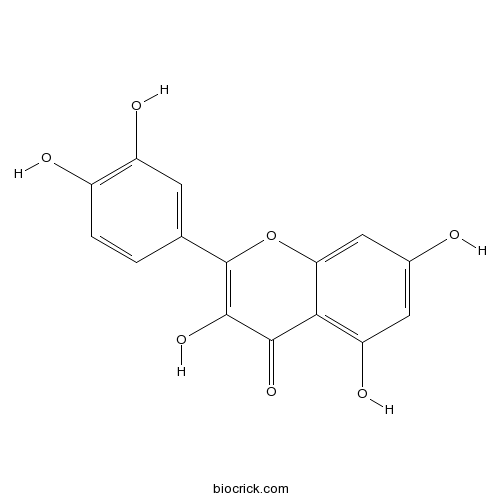A pentahydroxyflavone having the five hydroxy groups placed at the 3-, 3'-, 4'-, 5- and 7-positions. It is one of the most abundant flavonoids in edible vegetables, fruit and wine.
InChI=1S/C15H10O7/c16-7-4-10(19)12-11(5-7)22-15(14(21)13(12)20)6-1-2-8(17)9(18)3-6/h1-5,16-19,21H
Quercetin, a member of the flavonoids family, is one of the most prominent dietary antioxidants. It is ubiquitously present in foods including vegetables, fruit, tea and wine as well as countless food supplements and is claimed to exert beneficial health effects. This includes protection against various diseases such as osteoporosis, certain forms of cancer, pulmonary and cardiovascular diseases but also against aging. [1]
Quercetin aglycone modulates several signal transduction pathways involving MEK/ERK and Nrf2/keap1, which are associated with the processes of inflammation and carcinogenesis.[2]
Guercetin can attenuate the function of AR by repressing its expression, inhibit the secretion of the prostate-specific, androgen-regulated tumor markers, PSA and hK2. and has the potential to become a chemopreventive and/or chemotherapeutic agent for prostate cancer.[3]
Quercetin and curcumin modulate ACFs correlates well with their ability to induce apoptosis via the mitochondrial pathway, may exert significant and potentially beneficial effects on decreasing the amount of precancerous lesions and inducing apoptosis in the large intestine.[4]
Quercetin supplementation reduces blood pressure in hypertensive subjects.[5]
[1] Boots A W, Haenen G R M M, Bast A.Eur J Phamarmacol , 2008, 585(2–3):325-37.
[2] Murakami A, Ashida H, Terao J.Cancer Lett , 2008, 269(2):315–25.
[3] Xing N, Chen Y, Mitchell S H, et al. Carcinogenesis, 2001, volume 22(22):409-14.
[4] Volate S R, Davenport D M, Muga S J, et al. Carcinogenesis, 2005, 26(8):1450-6.
[5] Edwards R L, Lyon T, Litwin S E, et al. Brit J Nutr, 2007, 137(11):2405-11.
[6] Liu H P, Shi X F, Zhang Y C, et al. Cell Biochem Biophy, 2011, 61(1):59-64.



